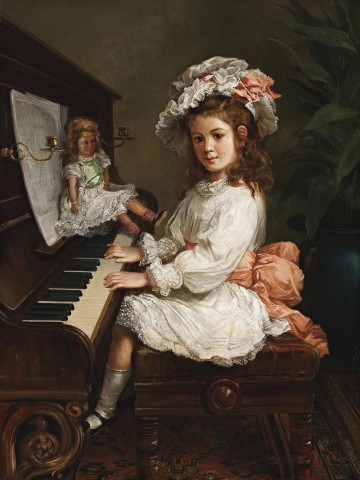PORTRAIT OF MISS WINIFRED HUDSON AS A YOUNG GIRL, SEATED AT A PIANO, HER DOLL NEARBY, 1888
NICHOLAS CHEVALIER
oil on canvas
122.0 x 91.5 cm
signed and dated lower left: Nicholas Chevalier 1888
inscribed on stretcher bar verso: Completed from sketches on my 60th birthday / Painted in Wellington, Auckland and Melbourne. / N. Chevalier / by sea to R.M. Hudson. / Departure port of Melbourne
Commissioned by Ralph M. Hudson
Thence by descent
Major Paul I.C. Payne, United Kingdom
Tennants Auctioneers, Leyburn, United Kingdom, 19 November 2009, lot 1031
Private collection, Melbourne
Nicholas Chevalier: Australian Odyssey, Gippsland Art Gallery, Victoria, 17 September – 13
November 2011; Geelong Art Gallery, Victoria, 26 November 2011 – 12 February 2012, cat. 173
(illus. in exhibition catalogue)
Cosmopolitan, exceedingly handsome, an engaging conversationalist, Nicholas Chevalier was a singularly talented person. Brilliant linguist and gifted musician, he was noted for his works in watercolour and oil. In 1864, his large landscape, The Buffalo Ranges, was given the £200 acquisitive prize by the recently founded National Gallery of Victoria, Melbourne, thereby becoming the first painting of an Australian subject to enter the Gallery’s collection. Born in St. Petersburg, Russia, Chevalier studied painting in Lausanne and architecture in Munich. Moving to London in 1851, his diversity of interests led to exhibiting at the Royal Academy, illustrating books and designing the setting for the Koh-i-Noor diamond. By 1855, changing family fortunes saw him in Melbourne and then the Bendigo goldfields. Back in Melbourne, he soon became a very popular cartoonist with the newly founded Punch. Marrying Caroline Wilkie, a relation of Sir David Wilkie, they settled in Melbourne, where their home became a centre for the cultivated, gifted and witty.
From designing decorations for the Victorian state visit of the Duke of Edinburgh, to eventually joining the Duke on board H.M.S. Galatea on tour of the Pacific Islands and the East, Chevalier eventually returned to London. Numerous royal commissions flowed from Queen Victoria and other members of the Royal Family, while Chevalier played second violin to the Duke in the Royal Amateur Orchestral Society. Exhibiting at the Paris Salon and the Royal Academy, he continued a particular connection with Australia through his appointment, in 1882, as London advisor to the then named National Gallery of New South Wales, Sydney.
In the Antipodes, Chevalier had travelled extensively in Victoria, Australia and New Zealand, sometimes with scientific expeditions and his leading contemporary Eugene von Guérard. A foundation member of the Victorian Society of Fine Arts, Chevalier numerous landscapes in their annual expeditions, but very few portraits. The year 1860 was most unusual. While it included The Yarra above Yarra Bend and the Burke and Wills history piece, Memorandum of the Start of the Exploring Expedition 1860, now in the M. J. M. Carter Collection, Art Gallery of South Australia, Adelaide, it also featured the equestrian Portrait of Master George Holmes, (son of the owner of the Yarra Bend painting mentioned previously), together with Portrait of the Artist, (gifted years later to the Art Gallery of New South Wales, Sydney), and Portrait of a Boy.
Commencing with the grant of £200 Chevalier received from the Otago Provincial Council in 1865 to paint the scenic beauties of the area, through sketching, travelling and exhibiting widely, Chevalier maintained a strong connection with New Zealand. He likewise New Zealand subjects at the Royal Academy, London, in the years 1884 to 1886. Finally, he sent three works to the New Zealand and South Sea Exhibition at Dunedin in 1889-90. While speculation surrounds a New Zealand connection with Portrait of Miss Winifred Hudson as a Young Girl, Seated at a Piano, Her Doll Nearby, 1888, it can be observed confidently that Chevalier painted this charming Victorian piece in his sixtieth year. Miss Hudson hatted and dressed in her lace-edged fineries, her favourite doll for company, Chevalier equips the scene with visual delights, contrasting polished wood with Oriental rug, the aspidistra, symbol of Victorian middle class standing, proudly holding up its corner.
DAVID THOMAS
